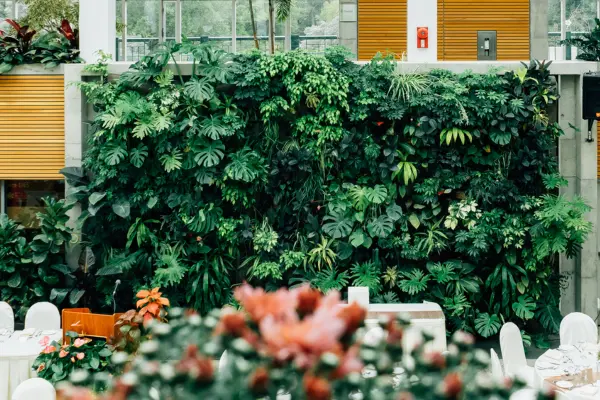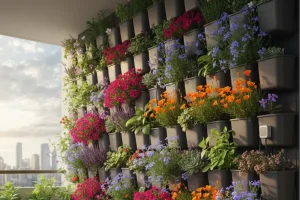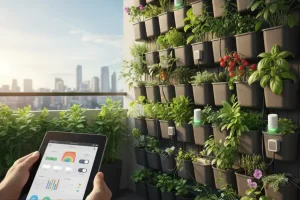In a vertical garden, water circulation is everything. Without a reliable pump, plants at the top may dry out while those at the bottom get flooded. Choosing the right water pump keeps your system running smoothly, ensures even watering, and saves you from constant troubleshooting.
This guide explains how to select the best pump for your vertical garden, whether it’s a small balcony tower or a larger backyard system.
Why the Pump Matters
Vertical gardens rely on a pump to lift water from the reservoir and deliver it to plant roots at the right pressure and timing. In other words, the pump is the “heart” of your system—if it’s weak, inconsistent, or poorly sized, everything else struggles. The right pump determines:
- Consistency: Steady, predictable flow means every pocket or panel gets the moisture it needs—no dry corners, no soggy middle rows. Consistency supports even growth and healthier roots.
- Efficiency: A properly sized, energy-smart pump reduces water and electricity waste, helps prevent overwatering, and keeps run times short and targeted.
- System health: In hydroponic setups, continuous circulation keeps nutrients mixed, oxygenates the solution, and discourages algae and salt buildup.
- Reliability & lifespan: A pump that isn’t working at its limit runs cooler and lasts longer, saving you from surprise failures during heat waves or vacations.
- Noise & comfort: Quieter pumps make indoor gardens more pleasant, especially in living rooms or offices.
Choose well up front, and your vertical garden stays balanced, low-maintenance, and productive.
A pump that’s too weak won’t push water to the top, while one that’s too strong can waste energy and overwhelm roots.
Step 1: Know Your Garden Size
The first step in pump selection is measuring your garden.
- Small indoor towers (2–4 ft): Require small submersible pumps with low flow rates.
- Medium setups (4–6 ft): Need stronger pumps that can push water higher while maintaining steady flow.
- Large outdoor walls or towers (6–10 ft+): Benefit from pumps with higher capacity and durability.
Step 2: Understand Key Pump Ratings
1. Flow Rate (GPH/LPH):
- Measured in gallons (or liters) per hour.
- A good rule: Choose a pump that circulates your reservoir volume at least once every hour.
2. Head Height (Lift):
- The maximum height a pump can push water.
- Make sure it exceeds the tallest point of your vertical garden.
3. Energy Efficiency:
- For indoor gardens, choose low-watt pumps to keep electricity costs down.
- For outdoor systems, durability matters more than power savings.
Step 3: Choose Pump Type
- Submersible Pumps: Placed directly in the reservoir. Compact, easy to install, best for small–medium gardens.
- Inline Pumps: Sit outside the reservoir, usually more powerful, ideal for large or commercial setups.
Step 4: Match Pump to System Type
- Hydroponic towers: Require consistent water flow, so reliability is crucial.
- Soil-based vertical gardens with drip irrigation: Can use smaller pumps since watering is less frequent.
- Aquaponics systems: Need pumps that can handle water with fish waste and debris.
Pump Selection Quick Guide
| Garden Size | Recommended Pump | Flow Rate (GPH) | Notes |
| Small indoor (2–4 ft) | Submersible | 80–200 GPH | Compact, quiet |
| Medium (4–6 ft) | Submersible | 200–400 GPH | Balance of power & efficiency |
| Large (6–10 ft+) | Inline or heavy-duty submersible | 400–800+ GPH | Durable, strong lift |
| Aquaponics | Inline/submersible with filter | 300–600 GPH | Handles solids |
Common Mistakes to Avoid
Ignoring head height: A pump can boast a big flow rate at 0 m head, but flow drops as it pushes water upward. If your wall is 1.5–2 m tall, a “strong” pump on paper may trickle at the top row.
Fix: Measure from the water surface to the highest emitter, add 20–30% for bends and filters, and choose a pump that still meets your target flow at that head.
Buying oversized pumps: More power isn’t always better. Oversized pumps waste energy, create noisy turbulence, and can blast media out of pockets or overwater seedlings.
Fix: Right-size first. If you prefer flexibility, pick a DC pump with a speed controller or add a bypass valve to bleed off excess flow back to the reservoir.
Skipping a backup pump: Pumps are moving parts—they wear, clog, or fail at the worst times (vacations, heat waves). A few hours without water can stress or kill a vertical garden.
Fix: Keep a spare pump and matching fittings on hand. Label it, test it once, and store it clean and dry.
Not cleaning filters and lines: Debris, fertilizer crystals, and biofilm choke performance, causing weak top rows and drippers that stop altogether.
Fix: Install a pre-filter and rinse it weekly. Do a quick flush of tubing monthly, and run a reservoir deep-clean every 4–6 weeks to keep flow steady.
Skipping a test run: Going straight to nutrients hides problems until leaves wilt.
Fix: Test with plain water for 15–20 minutes, check evenness row by row, and only then add nutrients and start your schedule.
FAQs
Q: How often should I run my pump?
Most vertical hydroponic systems run pumps on cycles (e.g., 15 minutes every 2–3 hours). Soil systems may need less frequent watering.
Q: Are aquarium pumps suitable?
Yes, for small systems. For larger towers, garden-specific pumps work better.
Q: Can I use solar-powered pumps?
Yes. They’re great for off-grid or eco-friendly setups but may need battery backup on cloudy days.
Q: How long do pumps last?
Typically 1–3 years, depending on use and maintenance.
Next Steps & Related Reading
Once your pump is set, pair it with a drip irrigation kit for precision watering (see Best Drip-Irrigation Kits for Small-Scale Vertical Gardens).
If you’re considering energy efficiency, explore Portable Power Solutions for Off-Grid Vertical Gardens.
Conclusion
Selecting the right water pump is all about matching your garden size and system type to the correct flow rate and lift capacity. A well-chosen pump ensures even watering, healthier plants, and less daily maintenance.
Would you prioritize a quiet, energy-saving pump for your indoor setup, or a heavy-duty one for outdoor durability?




